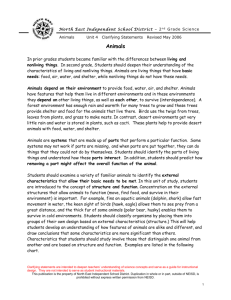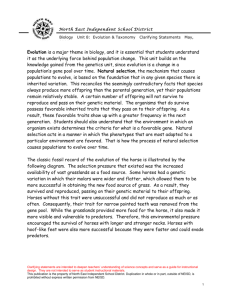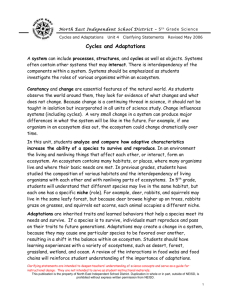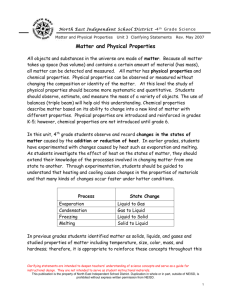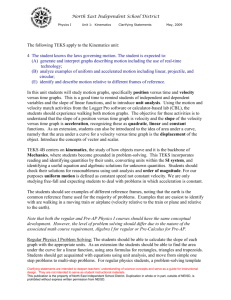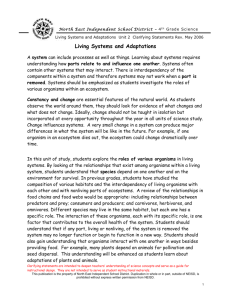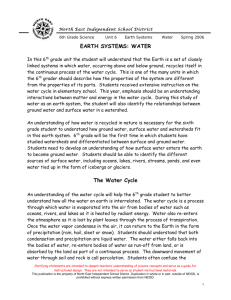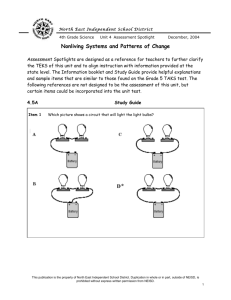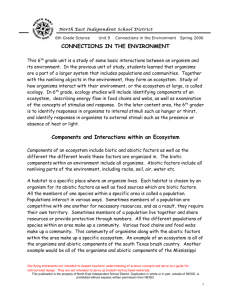Cycles and Adaptations - North East Independent School District
advertisement
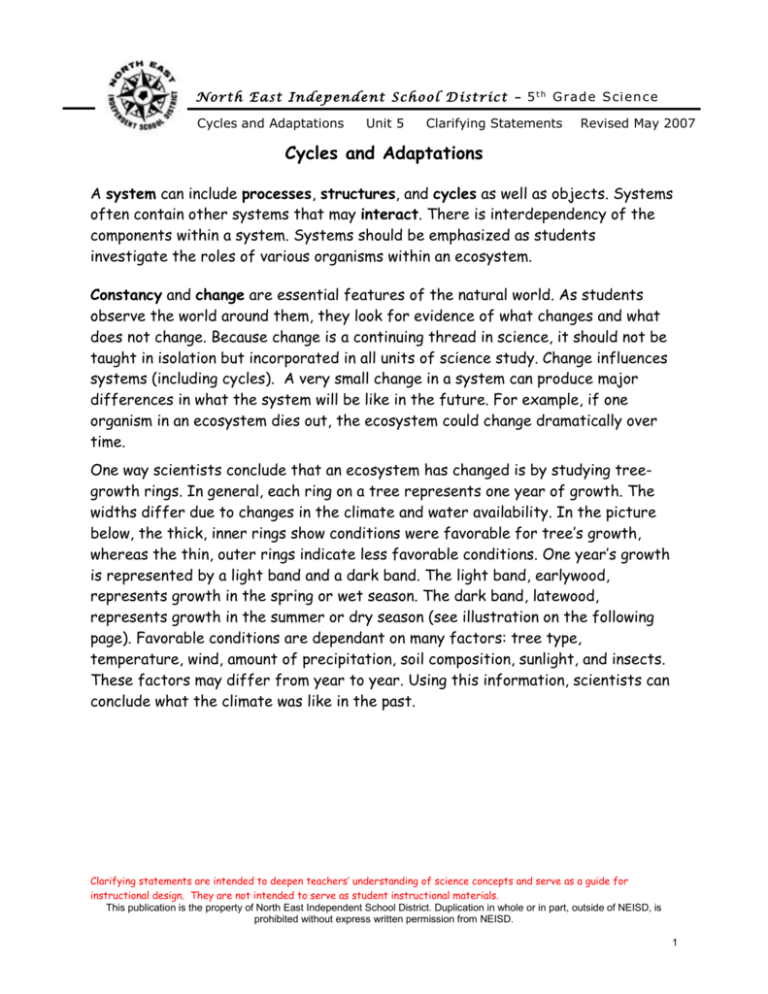
N o r t h E a st I n d ep en d e nt S c h o o l D i st ric t – 5 t h G rad e S ci en c e Cycles and Adaptations Unit 5 Clarifying Statements Revised May 2007 Cycles and Adaptations A system can include processes, structures, and cycles as well as objects. Systems often contain other systems that may interact. There is interdependency of the components within a system. Systems should be emphasized as students investigate the roles of various organisms within an ecosystem. Constancy and change are essential features of the natural world. As students observe the world around them, they look for evidence of what changes and what does not change. Because change is a continuing thread in science, it should not be taught in isolation but incorporated in all units of science study. Change influences systems (including cycles). A very small change in a system can produce major differences in what the system will be like in the future. For example, if one organism in an ecosystem dies out, the ecosystem could change dramatically over time. One way scientists conclude that an ecosystem has changed is by studying treegrowth rings. In general, each ring on a tree represents one year of growth. The widths differ due to changes in the climate and water availability. In the picture below, the thick, inner rings show conditions were favorable for tree’s growth, whereas the thin, outer rings indicate less favorable conditions. One year’s growth is represented by a light band and a dark band. The light band, earlywood, represents growth in the spring or wet season. The dark band, latewood, represents growth in the summer or dry season (see illustration on the following page). Favorable conditions are dependant on many factors: tree type, temperature, wind, amount of precipitation, soil composition, sunlight, and insects. These factors may differ from year to year. Using this information, scientists can conclude what the climate was like in the past. Clarifying statements are intended to deepen teachers’ understanding of science concepts and serve as a guide for instructional design. They are not intended to serve as student instructional materials. This publication is the property of North East Independent School District. Duplication in whole or in part, outside of NEISD, is prohibited without express written permission from NEISD. 1 N o r t h E a st I n d ep en d e nt S c h o o l D i st ric t – 5 t h G rad e S ci en c e Cycles and Adaptations Unit 5 Clarifying Statements Revised May 2007 Clarifying statements are intended to deepen teachers’ understanding of science concepts and serve as a guide for instructional design. They are not intended to serve as student instructional materials. This publication is the property of North East Independent School District. Duplication in whole or in part, outside of NEISD, is prohibited without express written permission from NEISD. 2 N o r t h E a st I n d ep en d e nt S c h o o l D i st ric t – 5 t h G rad e S ci en c e Cycles and Adaptations Unit 5 Clarifying Statements Revised May 2007 In this unit, students analyze and compare how adaptive characteristics increase the ability of a species to survive and reproduce. In an environment the living and nonliving things that affect each other, or interact, form an ecosystem. An ecosystem contains many habitats, or places, where many organisms live and where their basic needs are met. In previous grades, students have studied the composition of various habitats and the interdependency of living organisms with each other and with nonliving parts of ecosystems. In 5th grade, students will understand that different species may live in the same habitat, but each one has a specific niche (role). For example, deer, rabbits, and squirrels may live in the same leafy forest, but because deer browse higher up on trees, rabbits graze on grasses, and squirrels eat acorns, each animal occupies a different niche. Adaptations are inherited traits and learned behaviors that help a species meet its needs and survive. If a species is to survive, individuals must reproduce and pass on their traits to future generations. Adaptations may create a change in a system, because they may cause one particular species to be favored over another, resulting in a shift in the balance within an ecosystem. Students should have learning experiences with a variety of ecosystems, such as desert, forest, grassland, wetland, and ocean. A review of the interactions in food webs and food chains will reinforce student understanding of the importance of adaptations. The arrows in a food web or food chain should always show the flow of energy through a system. They should point from the organism being consumed to the organism doing the consuming. Example of a simple food chain with arrows showing energy flow: Example of a food web with arrows showing energy flow: Clarifying statements are intended to deepen teachers’ understanding of science concepts and serve as a guide for instructional design. They are not intended to serve as student instructional materials. This publication is the property of North East Independent School District. Duplication in whole or in part, outside of NEISD, is prohibited without express written permission from NEISD. 3 N o r t h E a st I n d ep en d e nt S c h o o l D i st ric t – 5 t h G rad e S ci en c e Cycles and Adaptations Unit 5 Clarifying Statements Revised May 2007 Sun By describing the unique adaptive characteristics of various species, students will understand how a diversity of organisms can co-exist within an ecosystem. By identifying the commonalities of organisms adapted to a particular ecosystem, students will predict whether an organism can survive and reproduce. For example, desert organisms have adaptations to conserve water; therefore, a rain forest plant, lacking this adaptation, will not be able to survive in a desert. All living things reproduce to make more of their own kind. The stages in the life of a living organism as it grows, develops, and matures to reproduce to the next generation are known as its life cycle. Students will describe and compare life cycles of plants and animals. The following charts provide a basis for comparisons of plants and animals. Students should note differences and similarities between and within the life cycles of plants and animals. Clarifying statements are intended to deepen teachers’ understanding of science concepts and serve as a guide for instructional design. They are not intended to serve as student instructional materials. This publication is the property of North East Independent School District. Duplication in whole or in part, outside of NEISD, is prohibited without express written permission from NEISD. 4 N o r t h E a st I n d ep en d e nt S c h o o l D i st ric t – 5 t h G rad e S ci en c e Cycles and Adaptations Unit 5 Clarifying Statements Revised May 2007 Animals Hatch from eggs Birds Insects Live birth Most mammals Some fish Plants Non-seed Plants (Spores) Mosses Ferns Seed Plants (Seeds) Flowering Plants Conifers Clarifying statements are intended to deepen teachers’ understanding of science concepts and serve as a guide for instructional design. They are not intended to serve as student instructional materials. This publication is the property of North East Independent School District. Duplication in whole or in part, outside of NEISD, is prohibited without express written permission from NEISD. 5 N o r t h E a st I n d ep en d e nt S c h o o l D i st ric t – 5 t h G rad e S ci en c e Cycles and Adaptations Unit 5 Clarifying Statements Revised May 2007 The focus for students is to compare, not memorize, plant and animal life cycles. For example, students could compare the life cycles of the sparrow and rabbit as in the diagram below. Sparrows Hatch from egg Nest in a tree Feed their young Rabbits Nests Parents care for young Young look like parents Grow and change Live birth Nest in a burrow Nurse their young Organisms have two main types of traits: those that are inherited and those that are learned. Inherited traits are passed from parents to offspring in plants and animals. In previous grades students learned that offspring generally look like their parents. In fifth grade this concept should be expanded to include more specific examples and to further differentiate between inherited and learned characteristics. When studying learned characteristics, the focus in 5th grade shifts to those behaviors that result from environmental influence. Some examples are outlined in the chart. Clarifying statements are intended to deepen teachers’ understanding of science concepts and serve as a guide for instructional design. They are not intended to serve as student instructional materials. This publication is the property of North East Independent School District. Duplication in whole or in part, outside of NEISD, is prohibited without express written permission from NEISD. 6 N o r t h E a st I n d ep en d e nt S c h o o l D i st ric t – 5 t h G rad e S ci en c e Cycles and Adaptations Unit 5 Inherited Revised May 2007 Learned-Environmental influence The color of your hair Penguins huddling to keep warm A snake’s skin A leaf’s shape A raspberry bush produces raspberries A giraffe’s long neck Clarifying Statements A cow runs at the sound of a rattle snake Fish come to the top of the bowl when you feed them When the fire alarm sounds, we exit the building Rabbit avoiding sharp cactus spines Cycles Most of the materials that organisms need are present in an ecosystem and are cycled through nature and used and reused by living organisms. Students must understand the significance of the carbon, nitrogen, and water cycles in relation to animals, plants, and ecosystems. These cycles are introduced in The Natural World while mastery of the carbon, nitrogen and water cycles are accomplished during this unit of study. The carbon cycle is the continual movement of carbon dioxide and oxygen between living things in ecosystems. Living organisms get the oxygen they need in order to live by breathing air. They utilize the oxygen in the air during respiration and release carbon dioxide back into the air as a waste product of this process. Plants need carbon dioxide to make food during photosynthesis-the process by which plants capture light energy from the sun and use it to manufacture food (sugars) from carbon dioxide and water. Oxygen is released back to environment as a waste product of this process. Decomposition is also a process that contributes to this cycle. Fungi and bacteria obtain energy by breaking down waste or remains of other living things. Carbon dioxide is released into the environment through this process. Clarifying statements are intended to deepen teachers’ understanding of science concepts and serve as a guide for instructional design. They are not intended to serve as student instructional materials. This publication is the property of North East Independent School District. Duplication in whole or in part, outside of NEISD, is prohibited without express written permission from NEISD. 7 N o r t h E a st I n d ep en d e nt S c h o o l D i st ric t – 5 t h G rad e S ci en c e Cycles and Adaptations Unit 5 Clarifying Statements Revised May 2007 Decomposers release carbon dioxide. Teacher background, please note: Plants also carry on respiration and use oxygen in a similar way to animals. This process is different from photosynthesis. A common misconception that many students and adults hold is that plants do not need oxygen. Plants use oxygen to carry on respiration within their cells to release the energy they have made. Clarifying statements are intended to deepen teachers’ understanding of science concepts and serve as a guide for instructional design. They are not intended to serve as student instructional materials. This publication is the property of North East Independent School District. Duplication in whole or in part, outside of NEISD, is prohibited without express written permission from NEISD. 8 N o r t h E a st I n d ep en d e nt S c h o o l D i st ric t – 5 t h G rad e S ci en c e Cycles and Adaptations Unit 5 Clarifying Statements Revised May 2007 The nitrogen cycle is the constant movement of nitrogen between living things and the environment. Nitrogen is one substance needed to make up structures in living organisms. It is the most abundant gas in the atmosphere, but most organisms cannot use this form of nitrogen. Decomposers return nitrogen compounds from dead organisms into the soil. The processes in the nitrogen cycle change the nitrogen into usable forms for living organisms. After nitrogen gas is changed to a form plants can use, plants pass the nitrogen to animals through the food chain. Plants and animals return nitrogen to the environment in their wastes. Bacteria break down this form of nitrogen and release nitrogen gas back into the atmosphere. Clarifying statements are intended to deepen teachers’ understanding of science concepts and serve as a guide for instructional design. They are not intended to serve as student instructional materials. This publication is the property of North East Independent School District. Duplication in whole or in part, outside of NEISD, is prohibited without express written permission from NEISD. 9 N o r t h E a st I n d ep en d e nt S c h o o l D i st ric t – 5 t h G rad e S ci en c e Cycles and Adaptations Unit 5 Clarifying Statements Revised May 2007 The water cycle is the constant movement of water between the surface of the Earth and the atmosphere through the processes of evaporation and transpiration, condensation, and precipitation. In previous grades students learned the process of evaporation, condensation, and precipitation. In fifth grade students should understand that transpiration is a loss of water through a plant’s leaves. Transpiration Clarifying statements are intended to deepen teachers’ understanding of science concepts and serve as a guide for instructional design. They are not intended to serve as student instructional materials. This publication is the property of North East Independent School District. Duplication in whole or in part, outside of NEISD, is prohibited without express written permission from NEISD. 10 N o r t h E a st I n d ep en d e nt S c h o o l D i st ric t – 5 t h G rad e S ci en c e Cycles and Adaptations Unit 5 Clarifying Statements Revised May 2007 Cycles and Adaptations (cont’d) Note: Many campuses use the Constancy and Change Vistas, which contain lessons on either lifecycles or adaptations. The Vistas suggest the following organisms (focus is indicated in parenthesis): Kindergarten – Ladybugs (life cycle) 3rd Grade – Frogs (adaptations) 1st Grade – Mealworms (life cycle) 4th Grade – Bats (adaptations) 2nd Grade – Butterflies (life cycle) 5th Grade – Brown Pelican (adaptations) Dissections are not recommended for elementary students. Clarifying statements are intended to deepen teachers’ understanding of science concepts and serve as a guide for instructional design. They are not intended to serve as student instructional materials. This publication is the property of North East Independent School District. Duplication in whole or in part, outside of NEISD, is prohibited without express written permission from NEISD. 11
